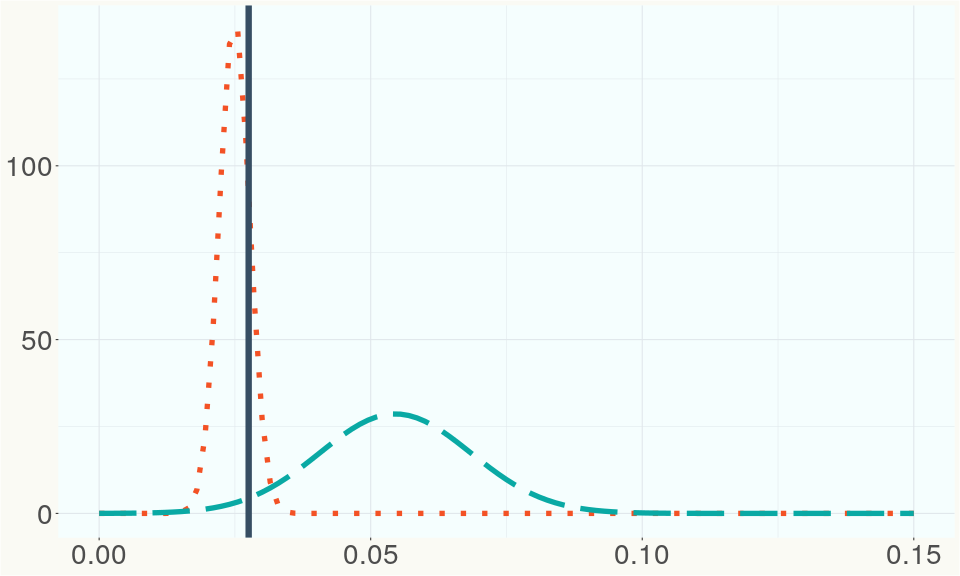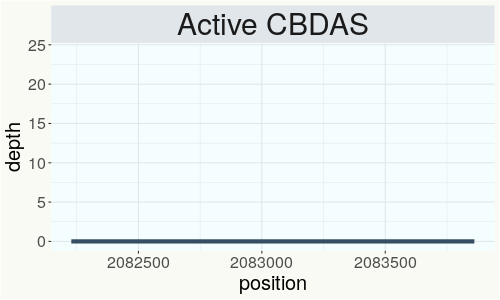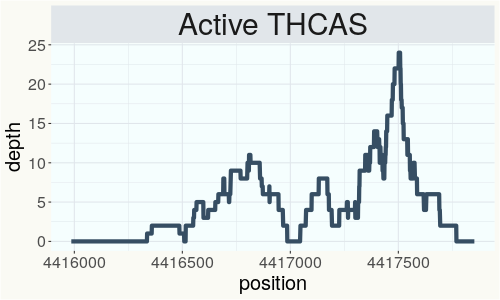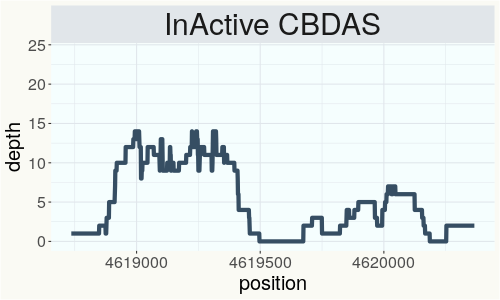DB
RSP 12936
Grower: Zamir Punja
General Information
- Sample Name
- DB - roots from flowering plant
- Accession Date
- September 27, 2023
- Reported Plant Sex
- Female
- Report Type
- Whole-Genome Sequencing
- Microbiome
- Krona Plot
- Fungal Microbiome
- Krona Plot
- Bacterial Microbiome
- Krona Plot
- Viral Microbiome
- Krona Plot
The strain rarity visualization shows how distant the strain is from the other cultivars in the Kannapedia database. The y-axis represents genetic distance, getting farther as you go up. The width of the visualization at any position along the y-axis shows how many strains there are in the database at that genetic distance. So, a common strain will have a more bottom-heavy shape, while uncommon and rare cultivars will have a visualization that is generally shifted towards the top.
Chemical Information
Cannabinoid and terpenoid information provided by the grower.
Cannabinoids
No information provided.
Terpenoids
No information provided.
Genetic Information
- Plant Type
- Type I
File Downloads
The bell curve in the heterozygosity visualization shows the distribution of heterozygosity levels for cannabis cultivars in the Kannapedia database. The green line shows where this particular strain fits within the distribution. Heterozygosity is associated with heterosis (aka hybrid vigor) but also leads to the production of more variable offspring. When plants have two genetically different parents, heterozygosity levels will be higher than if it has been inbred or backcrossed repeatedly.
The ratio of reads mapped to Y-contigs to reads mapped to the whole Cannabis genome (Y-ratios) has been demonstrated to be strongly correlated with plant sex typing. This plot shows the distribution of Y-ratios for all samples in our database which were sequenced with the same method (panel or WGS) as this sample and where this sample falls in the distribution.

This chart represents the Illumina sequence coverage over the Bt/Bd allele. These are the three regions in the cannabis genome that impact THCA, CBDA, CBGA production. Coverage over the Active CBDAS gene is highly correlated with Type II and Type III plants as described by Etienne de Meijer. Coverage over the THCA gene is highly correlated with Type I and Type II plants but is anti-correlated with Type III plants. Type I plants require coverage over the inactive CBDA loci and no coverage over the Active CBDA gene. Lack of coverage over the Active CBDA and Active THCA allele are presumed to be Type IV plants (CBGA dominant). While deletions of entire THCAS and CBDAS genes are the most common Bt:Bd alleles observed, it is possible to have plants with these genes where functional expression of the enzyme is disrupted by deactivating point mutations (Kojoma et al. 2006).



This chart represents the Illumina sequence coverage over the CBCA synthase gene.

Variants (THCAS, CBDAS, and CBCAS)
No variants to report
Variants (Select Genes of Interest)
| PHL-2 | c.2783G>A | p.Ser928Asn | missense variant | moderate | contig2621 | 342826 | G/A | |
| PHL-2 | c.3467A>G | p.Gln1156Arg | missense variant | moderate | contig2621 | 343510 | A/G | |
| DXR-2 | c.1319T>C | p.Ile440Thr | missense variant | moderate | contig380 | 285250 | A/G |
|
| FAD2-2 | c.110C>T | p.Ala37Val | missense variant | moderate | contig83 | 1803259 | G/A |
|
| FAD2-2 | c.62C>T | p.Pro21Leu | missense variant | moderate | contig83 | 1803307 | G/A |
|
| ELF3 | c.772A>G | p.Ser258Gly | missense variant | moderate | contig97 | 242478 | A/G |
|
| ELF3 | c.812G>C | p.Gly271Ala | missense variant | moderate | contig97 | 242518 | G/C | |
| ELF3 | c.1966C>G | p.Pro656Ala | missense variant | moderate | contig97 | 244797 | C/G | |
| ELF3 | c.2141C>G | p.Pro714Arg | missense variant | moderate | contig97 | 244972 | C/G | |
| HDS-2 |
c.82_93delGT |
p.Val28_Thr3 |
conservative inframe deletion | moderate | contig95 | 1989748 |
CGTAACCGGAAC |
|
| HDS-2 | c.127T>G | p.Ser43Ala | missense variant | moderate | contig95 | 1989794 | T/G |
|
| FAD4 | c.220C>G | p.Arg74Gly | missense variant | moderate | contig784 | 1690972 | C/G |
|
| PIE1-2 | c.1289A>G | p.Asp430Gly | missense variant | moderate | contig1460 | 1192109 | T/C |
|
| FLD | c.125G>A | p.Ser42Asn | missense variant | moderate | contig1450 | 2047909 | C/T | |
| AAE1-3 | c.722G>A | p.Arg241Lys | missense variant | moderate | contig976 | 1083132 | C/T |
|
| AAE1-3 | c.659G>A | p.Arg220Gln | missense variant | moderate | contig976 | 1083195 | C/T |
|
| AAE1-3 | c.634G>C | p.Gly212Arg | missense variant | moderate | contig976 | 1083220 | C/G |
|
| PIE1-1 | c.1222C>G | p.Gln408Glu | missense variant | moderate | contig1225 | 2281482 | C/G |
Nearest genetic relatives (All Samples)
- 0.092 DB (RSP12930)
- 0.186 Black Triangle (RSP11638)
- 0.193 The Gift (RSP10988)
- 0.201 501st OG (RSP11241)
- 0.201 PK (RSP12926)
- 0.210 Skywalker OG (RSP10837)
- 0.215 RKM-2018-021 (RSP11113)
- 0.215 RKM-2018-032 (RSP11124)
- 0.216 RKM-2018-008 (RSP11099)
- 0.217 GG 4 (RSP11461)
- 0.217 RKM-2018-017 (RSP11109)
- 0.217 RKM-2018-012 (RSP11103)
- 0.217 Animal Tree x [REDACTED] 4 (RSP12792)
- 0.219 PK (RSP12932)
- 0.224 SHERBERT (RSP11355)
- 0.224 Rugburn OG (RSP11353)
- 0.224 GG4 (RSP12096)
- 0.225 SFVxTK (RSP11072)
- 0.226 GG4 (RSP11978)
- 0.228 Tahoe OG (RSP11189)
Most genetically distant strains (All Samples)
- 0.468 Jamaican Lion (RSP12916)
- 0.467 Unknown- Cherry Wine - 003 (RSP11270)
- 0.461 JL yellow (RSP11075)
- 0.461 JL 3rd Gen Mother (RSP11214)
- 0.460 Cherry Blossom (RSP11317)
- 0.460 Unknown- Cherry Wine - 001 (RSP11268)
- 0.458 Jamaican Lion (RSP12915)
- 0.458 Jamaican Lion (RSP12917)
- 0.458 Tiger Tail 30 (RSP11484)
- 0.456 Unknown- Cherry Wine - 004 (RSP11271)
- 0.454 Tanao Sri 46 (RSP11486)
- 0.453 Cherry Blossom (RSP11311)
- 0.452 Unknown- Cherry Wine - 002 (RSP11269)
- 0.448 Jamaican Lion (RSP12913)
- 0.446 Cherry Blossom (RSP11298)
- 0.446 Cherry Fog XL (RSP11458)
- 0.445 Squirrel Tail 31 (RSP11485)
- 0.444 Cherry Blossom (RSP11308)
- 0.443 Northern Skunk (RSP11456)
- 0.443 Cherry Blossom (RSP11335)
Nearest genetic relative in Phylos dataset
- Overlapping SNPs:
- 61
- Concordance:
- 40
Nearest genetic relative in Lynch dataset
- Overlapping SNPs:
- 2
- Concordance:
- 2
Blockchain Registration Information
- Transaction ID
-
2dc469e58d782526
4844dc24324cf41a f0d07075e8562e60 af1f7ca99dd1efa8 - Stamping Certificate
- Download PDF (39.5 KB)
- SHASUM Hash
-
79c7b2cb90779596a66a1a969384360a 517890e8ef174af8 6288ff4b3de2eec1